Financial Decision Making: UK Coffee Industry and Roast plc
VerifiedAdded on 2023/01/17
|15
|4384
|46
Report
AI Summary
This report presents a comprehensive financial analysis of Roast plc, examining its performance within the UK coffee industry. The analysis begins with an industry review, highlighting key opportunities and challenges. It then delves into Roast plc's financial statements, including profit and loss accounts, balance sheets, and cash flow statements, comparing the years 2017 and 2018. Key financial ratios such as gross profit margin, net profit margin, current ratio, quick ratio, and return on capital employed are calculated and interpreted to assess the company's liquidity, profitability, and efficiency. Furthermore, the report discusses investment appraisal techniques and covers two sources of finance. The findings reveal improvements in Roast plc's financial performance in 2018 compared to 2017, with the exception of a decline in gross profit margin, and concludes with an assessment of the company's overall financial health and recommendations for improvement.
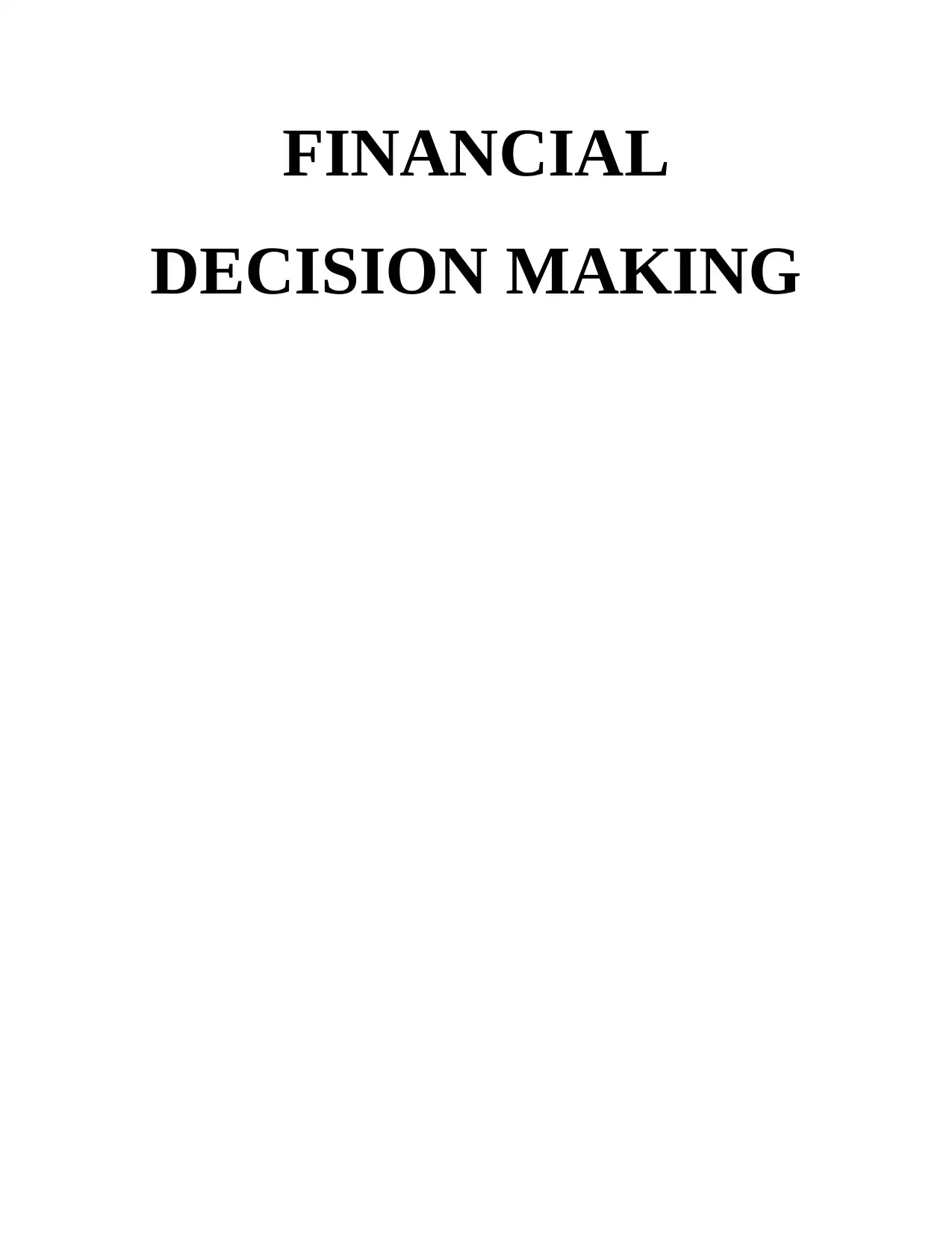
FINANCIAL
DECISION MAKING
DECISION MAKING
Paraphrase This Document
Need a fresh take? Get an instant paraphrase of this document with our AI Paraphraser
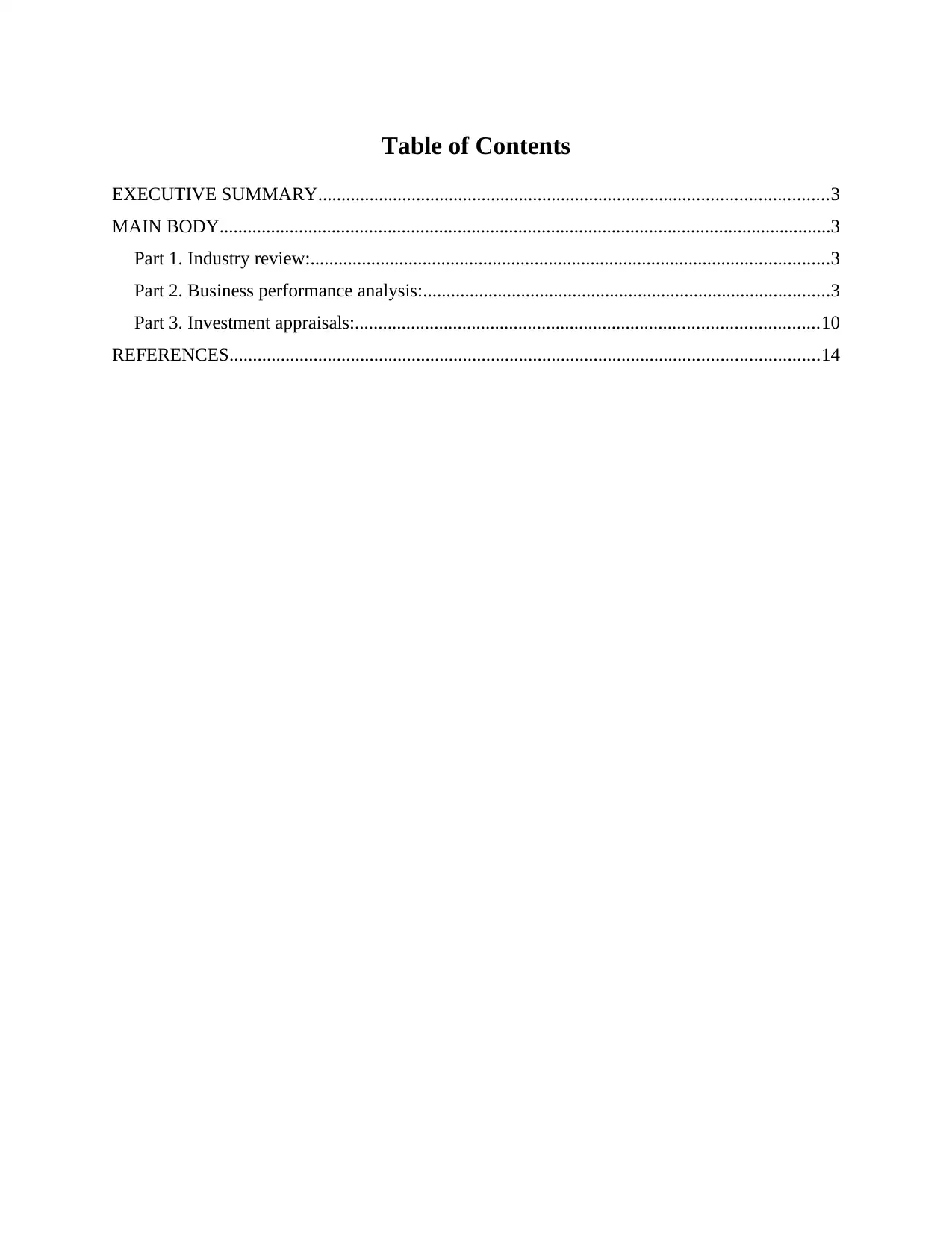
Table of Contents
EXECUTIVE SUMMARY.............................................................................................................3
MAIN BODY...................................................................................................................................3
Part 1. Industry review:...............................................................................................................3
Part 2. Business performance analysis:.......................................................................................3
Part 3. Investment appraisals:...................................................................................................10
REFERENCES..............................................................................................................................14
EXECUTIVE SUMMARY.............................................................................................................3
MAIN BODY...................................................................................................................................3
Part 1. Industry review:...............................................................................................................3
Part 2. Business performance analysis:.......................................................................................3
Part 3. Investment appraisals:...................................................................................................10
REFERENCES..............................................................................................................................14
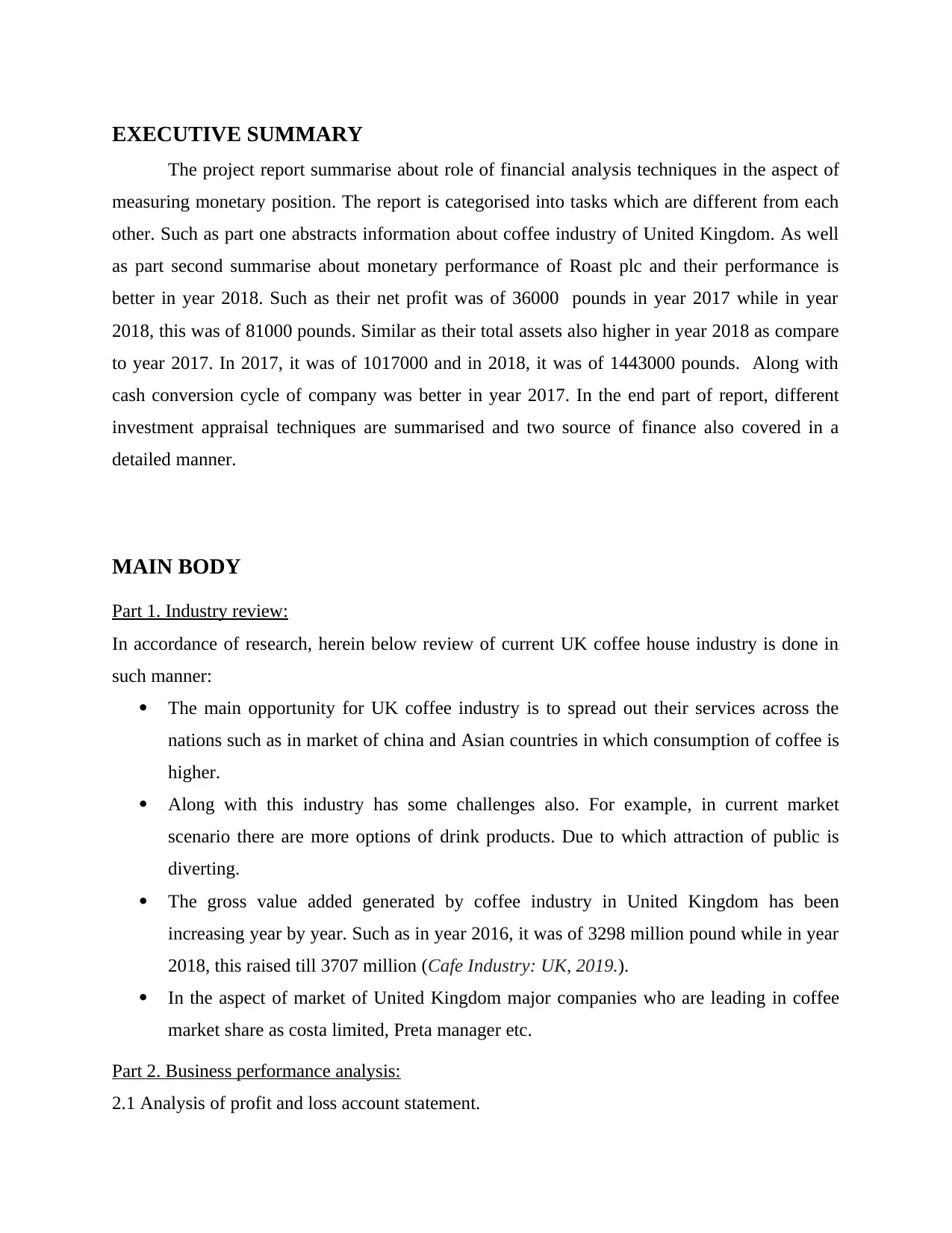
EXECUTIVE SUMMARY
The project report summarise about role of financial analysis techniques in the aspect of
measuring monetary position. The report is categorised into tasks which are different from each
other. Such as part one abstracts information about coffee industry of United Kingdom. As well
as part second summarise about monetary performance of Roast plc and their performance is
better in year 2018. Such as their net profit was of 36000 pounds in year 2017 while in year
2018, this was of 81000 pounds. Similar as their total assets also higher in year 2018 as compare
to year 2017. In 2017, it was of 1017000 and in 2018, it was of 1443000 pounds. Along with
cash conversion cycle of company was better in year 2017. In the end part of report, different
investment appraisal techniques are summarised and two source of finance also covered in a
detailed manner.
MAIN BODY
Part 1. Industry review:
In accordance of research, herein below review of current UK coffee house industry is done in
such manner:
The main opportunity for UK coffee industry is to spread out their services across the
nations such as in market of china and Asian countries in which consumption of coffee is
higher.
Along with this industry has some challenges also. For example, in current market
scenario there are more options of drink products. Due to which attraction of public is
diverting.
The gross value added generated by coffee industry in United Kingdom has been
increasing year by year. Such as in year 2016, it was of 3298 million pound while in year
2018, this raised till 3707 million (Cafe Industry: UK, 2019.).
In the aspect of market of United Kingdom major companies who are leading in coffee
market share as costa limited, Preta manager etc.
Part 2. Business performance analysis:
2.1 Analysis of profit and loss account statement.
The project report summarise about role of financial analysis techniques in the aspect of
measuring monetary position. The report is categorised into tasks which are different from each
other. Such as part one abstracts information about coffee industry of United Kingdom. As well
as part second summarise about monetary performance of Roast plc and their performance is
better in year 2018. Such as their net profit was of 36000 pounds in year 2017 while in year
2018, this was of 81000 pounds. Similar as their total assets also higher in year 2018 as compare
to year 2017. In 2017, it was of 1017000 and in 2018, it was of 1443000 pounds. Along with
cash conversion cycle of company was better in year 2017. In the end part of report, different
investment appraisal techniques are summarised and two source of finance also covered in a
detailed manner.
MAIN BODY
Part 1. Industry review:
In accordance of research, herein below review of current UK coffee house industry is done in
such manner:
The main opportunity for UK coffee industry is to spread out their services across the
nations such as in market of china and Asian countries in which consumption of coffee is
higher.
Along with this industry has some challenges also. For example, in current market
scenario there are more options of drink products. Due to which attraction of public is
diverting.
The gross value added generated by coffee industry in United Kingdom has been
increasing year by year. Such as in year 2016, it was of 3298 million pound while in year
2018, this raised till 3707 million (Cafe Industry: UK, 2019.).
In the aspect of market of United Kingdom major companies who are leading in coffee
market share as costa limited, Preta manager etc.
Part 2. Business performance analysis:
2.1 Analysis of profit and loss account statement.
⊘ This is a preview!⊘
Do you want full access?
Subscribe today to unlock all pages.

Trusted by 1+ million students worldwide
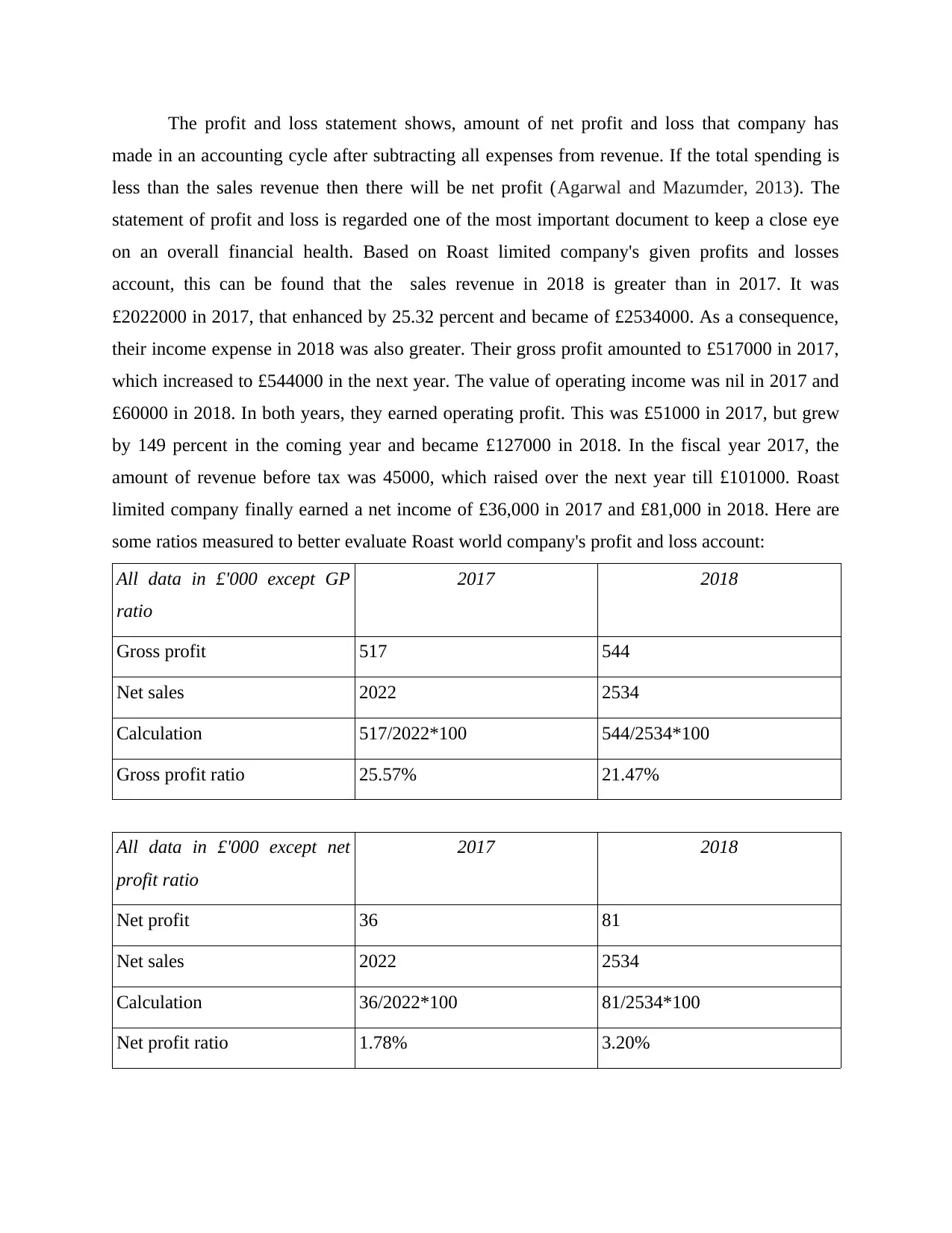
The profit and loss statement shows, amount of net profit and loss that company has
made in an accounting cycle after subtracting all expenses from revenue. If the total spending is
less than the sales revenue then there will be net profit (Agarwal and Mazumder, 2013). The
statement of profit and loss is regarded one of the most important document to keep a close eye
on an overall financial health. Based on Roast limited company's given profits and losses
account, this can be found that the sales revenue in 2018 is greater than in 2017. It was
£2022000 in 2017, that enhanced by 25.32 percent and became of £2534000. As a consequence,
their income expense in 2018 was also greater. Their gross profit amounted to £517000 in 2017,
which increased to £544000 in the next year. The value of operating income was nil in 2017 and
£60000 in 2018. In both years, they earned operating profit. This was £51000 in 2017, but grew
by 149 percent in the coming year and became £127000 in 2018. In the fiscal year 2017, the
amount of revenue before tax was 45000, which raised over the next year till £101000. Roast
limited company finally earned a net income of £36,000 in 2017 and £81,000 in 2018. Here are
some ratios measured to better evaluate Roast world company's profit and loss account:
All data in £'000 except GP
ratio
2017 2018
Gross profit 517 544
Net sales 2022 2534
Calculation 517/2022*100 544/2534*100
Gross profit ratio 25.57% 21.47%
All data in £'000 except net
profit ratio
2017 2018
Net profit 36 81
Net sales 2022 2534
Calculation 36/2022*100 81/2534*100
Net profit ratio 1.78% 3.20%
made in an accounting cycle after subtracting all expenses from revenue. If the total spending is
less than the sales revenue then there will be net profit (Agarwal and Mazumder, 2013). The
statement of profit and loss is regarded one of the most important document to keep a close eye
on an overall financial health. Based on Roast limited company's given profits and losses
account, this can be found that the sales revenue in 2018 is greater than in 2017. It was
£2022000 in 2017, that enhanced by 25.32 percent and became of £2534000. As a consequence,
their income expense in 2018 was also greater. Their gross profit amounted to £517000 in 2017,
which increased to £544000 in the next year. The value of operating income was nil in 2017 and
£60000 in 2018. In both years, they earned operating profit. This was £51000 in 2017, but grew
by 149 percent in the coming year and became £127000 in 2018. In the fiscal year 2017, the
amount of revenue before tax was 45000, which raised over the next year till £101000. Roast
limited company finally earned a net income of £36,000 in 2017 and £81,000 in 2018. Here are
some ratios measured to better evaluate Roast world company's profit and loss account:
All data in £'000 except GP
ratio
2017 2018
Gross profit 517 544
Net sales 2022 2534
Calculation 517/2022*100 544/2534*100
Gross profit ratio 25.57% 21.47%
All data in £'000 except net
profit ratio
2017 2018
Net profit 36 81
Net sales 2022 2534
Calculation 36/2022*100 81/2534*100
Net profit ratio 1.78% 3.20%
Paraphrase This Document
Need a fresh take? Get an instant paraphrase of this document with our AI Paraphraser
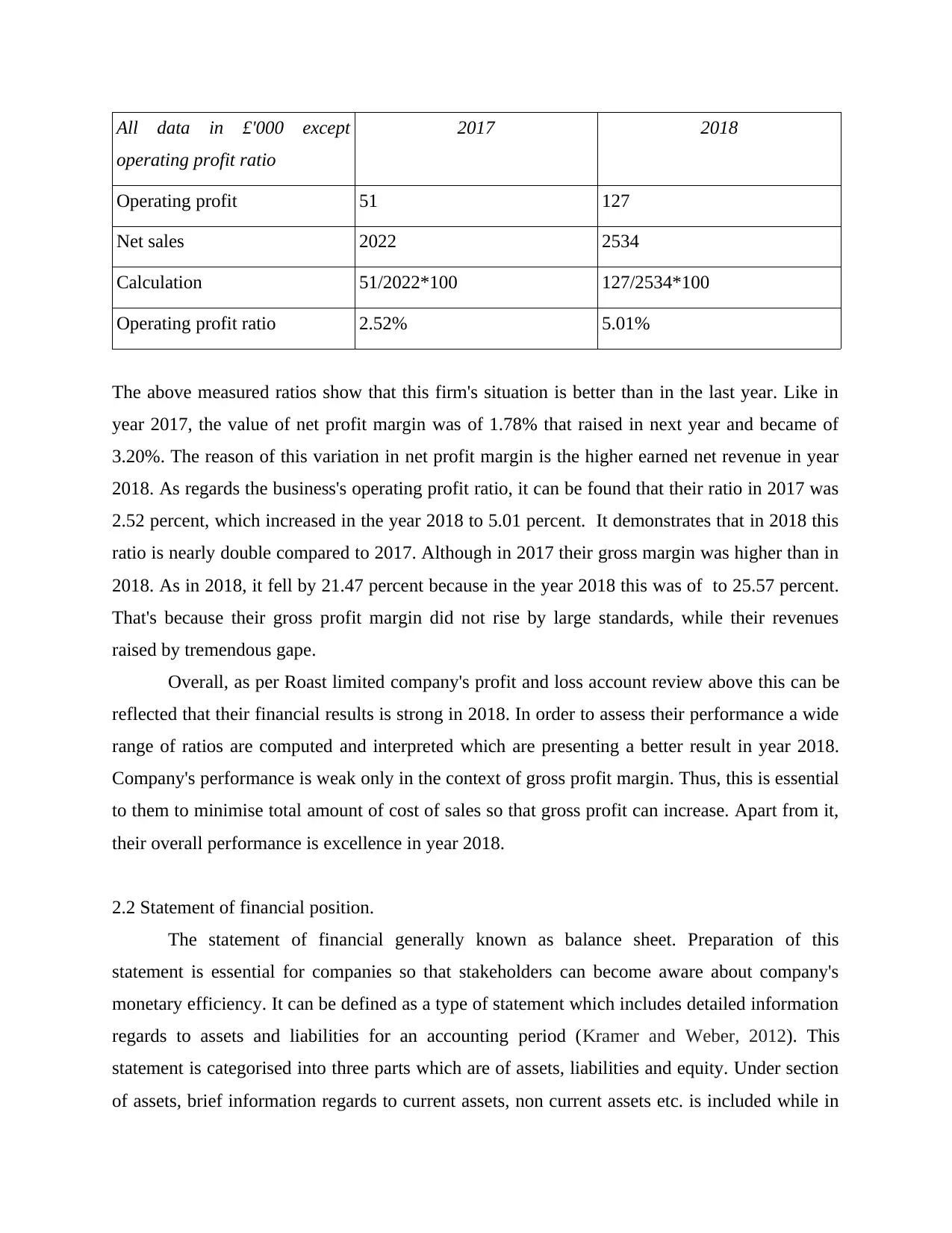
All data in £'000 except
operating profit ratio
2017 2018
Operating profit 51 127
Net sales 2022 2534
Calculation 51/2022*100 127/2534*100
Operating profit ratio 2.52% 5.01%
The above measured ratios show that this firm's situation is better than in the last year. Like in
year 2017, the value of net profit margin was of 1.78% that raised in next year and became of
3.20%. The reason of this variation in net profit margin is the higher earned net revenue in year
2018. As regards the business's operating profit ratio, it can be found that their ratio in 2017 was
2.52 percent, which increased in the year 2018 to 5.01 percent. It demonstrates that in 2018 this
ratio is nearly double compared to 2017. Although in 2017 their gross margin was higher than in
2018. As in 2018, it fell by 21.47 percent because in the year 2018 this was of to 25.57 percent.
That's because their gross profit margin did not rise by large standards, while their revenues
raised by tremendous gape.
Overall, as per Roast limited company's profit and loss account review above this can be
reflected that their financial results is strong in 2018. In order to assess their performance a wide
range of ratios are computed and interpreted which are presenting a better result in year 2018.
Company's performance is weak only in the context of gross profit margin. Thus, this is essential
to them to minimise total amount of cost of sales so that gross profit can increase. Apart from it,
their overall performance is excellence in year 2018.
2.2 Statement of financial position.
The statement of financial generally known as balance sheet. Preparation of this
statement is essential for companies so that stakeholders can become aware about company's
monetary efficiency. It can be defined as a type of statement which includes detailed information
regards to assets and liabilities for an accounting period (Kramer and Weber, 2012). This
statement is categorised into three parts which are of assets, liabilities and equity. Under section
of assets, brief information regards to current assets, non current assets etc. is included while in
operating profit ratio
2017 2018
Operating profit 51 127
Net sales 2022 2534
Calculation 51/2022*100 127/2534*100
Operating profit ratio 2.52% 5.01%
The above measured ratios show that this firm's situation is better than in the last year. Like in
year 2017, the value of net profit margin was of 1.78% that raised in next year and became of
3.20%. The reason of this variation in net profit margin is the higher earned net revenue in year
2018. As regards the business's operating profit ratio, it can be found that their ratio in 2017 was
2.52 percent, which increased in the year 2018 to 5.01 percent. It demonstrates that in 2018 this
ratio is nearly double compared to 2017. Although in 2017 their gross margin was higher than in
2018. As in 2018, it fell by 21.47 percent because in the year 2018 this was of to 25.57 percent.
That's because their gross profit margin did not rise by large standards, while their revenues
raised by tremendous gape.
Overall, as per Roast limited company's profit and loss account review above this can be
reflected that their financial results is strong in 2018. In order to assess their performance a wide
range of ratios are computed and interpreted which are presenting a better result in year 2018.
Company's performance is weak only in the context of gross profit margin. Thus, this is essential
to them to minimise total amount of cost of sales so that gross profit can increase. Apart from it,
their overall performance is excellence in year 2018.
2.2 Statement of financial position.
The statement of financial generally known as balance sheet. Preparation of this
statement is essential for companies so that stakeholders can become aware about company's
monetary efficiency. It can be defined as a type of statement which includes detailed information
regards to assets and liabilities for an accounting period (Kramer and Weber, 2012). This
statement is categorised into three parts which are of assets, liabilities and equity. Under section
of assets, brief information regards to current assets, non current assets etc. is included while in
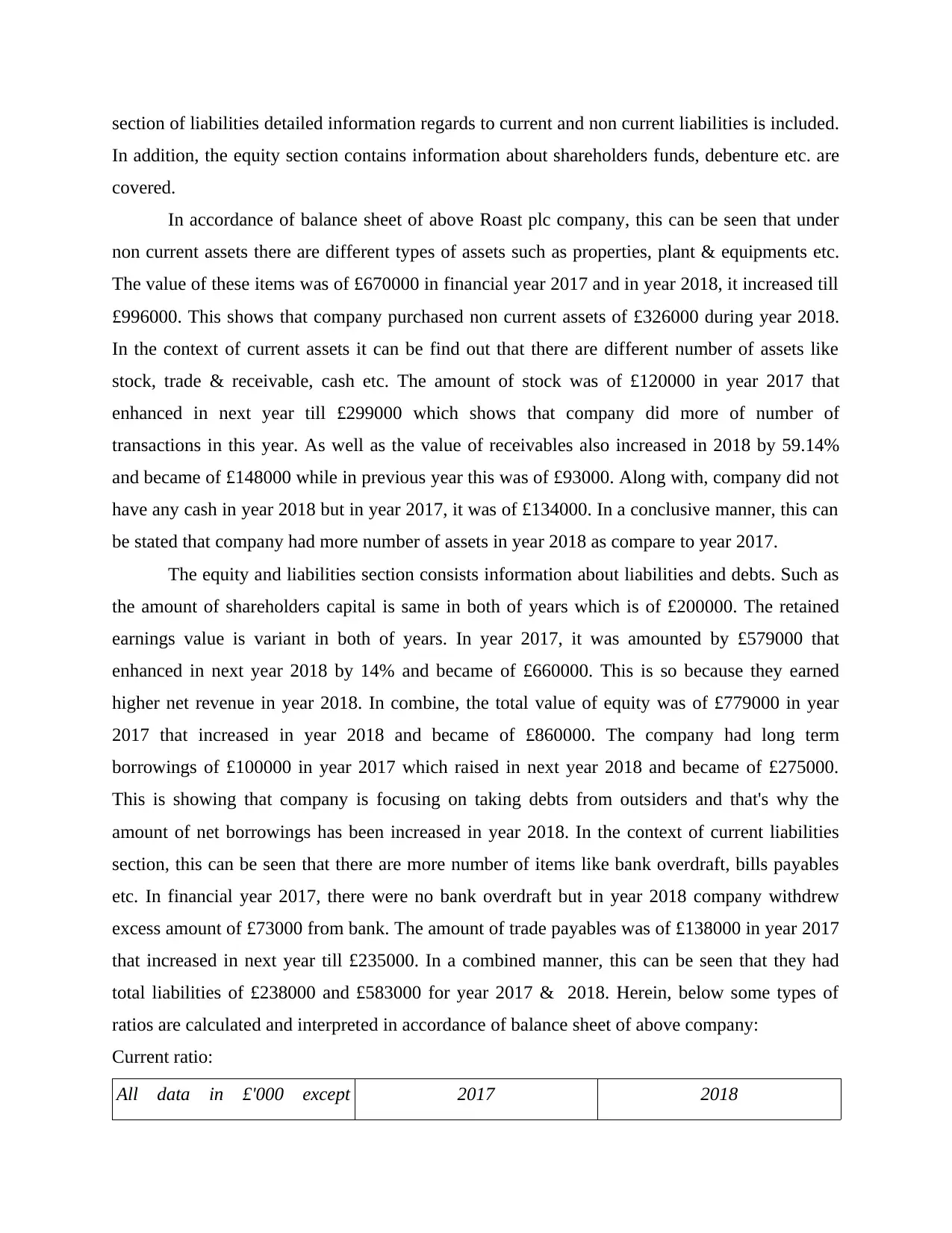
section of liabilities detailed information regards to current and non current liabilities is included.
In addition, the equity section contains information about shareholders funds, debenture etc. are
covered.
In accordance of balance sheet of above Roast plc company, this can be seen that under
non current assets there are different types of assets such as properties, plant & equipments etc.
The value of these items was of £670000 in financial year 2017 and in year 2018, it increased till
£996000. This shows that company purchased non current assets of £326000 during year 2018.
In the context of current assets it can be find out that there are different number of assets like
stock, trade & receivable, cash etc. The amount of stock was of £120000 in year 2017 that
enhanced in next year till £299000 which shows that company did more of number of
transactions in this year. As well as the value of receivables also increased in 2018 by 59.14%
and became of £148000 while in previous year this was of £93000. Along with, company did not
have any cash in year 2018 but in year 2017, it was of £134000. In a conclusive manner, this can
be stated that company had more number of assets in year 2018 as compare to year 2017.
The equity and liabilities section consists information about liabilities and debts. Such as
the amount of shareholders capital is same in both of years which is of £200000. The retained
earnings value is variant in both of years. In year 2017, it was amounted by £579000 that
enhanced in next year 2018 by 14% and became of £660000. This is so because they earned
higher net revenue in year 2018. In combine, the total value of equity was of £779000 in year
2017 that increased in year 2018 and became of £860000. The company had long term
borrowings of £100000 in year 2017 which raised in next year 2018 and became of £275000.
This is showing that company is focusing on taking debts from outsiders and that's why the
amount of net borrowings has been increased in year 2018. In the context of current liabilities
section, this can be seen that there are more number of items like bank overdraft, bills payables
etc. In financial year 2017, there were no bank overdraft but in year 2018 company withdrew
excess amount of £73000 from bank. The amount of trade payables was of £138000 in year 2017
that increased in next year till £235000. In a combined manner, this can be seen that they had
total liabilities of £238000 and £583000 for year 2017 & 2018. Herein, below some types of
ratios are calculated and interpreted in accordance of balance sheet of above company:
Current ratio:
All data in £'000 except 2017 2018
In addition, the equity section contains information about shareholders funds, debenture etc. are
covered.
In accordance of balance sheet of above Roast plc company, this can be seen that under
non current assets there are different types of assets such as properties, plant & equipments etc.
The value of these items was of £670000 in financial year 2017 and in year 2018, it increased till
£996000. This shows that company purchased non current assets of £326000 during year 2018.
In the context of current assets it can be find out that there are different number of assets like
stock, trade & receivable, cash etc. The amount of stock was of £120000 in year 2017 that
enhanced in next year till £299000 which shows that company did more of number of
transactions in this year. As well as the value of receivables also increased in 2018 by 59.14%
and became of £148000 while in previous year this was of £93000. Along with, company did not
have any cash in year 2018 but in year 2017, it was of £134000. In a conclusive manner, this can
be stated that company had more number of assets in year 2018 as compare to year 2017.
The equity and liabilities section consists information about liabilities and debts. Such as
the amount of shareholders capital is same in both of years which is of £200000. The retained
earnings value is variant in both of years. In year 2017, it was amounted by £579000 that
enhanced in next year 2018 by 14% and became of £660000. This is so because they earned
higher net revenue in year 2018. In combine, the total value of equity was of £779000 in year
2017 that increased in year 2018 and became of £860000. The company had long term
borrowings of £100000 in year 2017 which raised in next year 2018 and became of £275000.
This is showing that company is focusing on taking debts from outsiders and that's why the
amount of net borrowings has been increased in year 2018. In the context of current liabilities
section, this can be seen that there are more number of items like bank overdraft, bills payables
etc. In financial year 2017, there were no bank overdraft but in year 2018 company withdrew
excess amount of £73000 from bank. The amount of trade payables was of £138000 in year 2017
that increased in next year till £235000. In a combined manner, this can be seen that they had
total liabilities of £238000 and £583000 for year 2017 & 2018. Herein, below some types of
ratios are calculated and interpreted in accordance of balance sheet of above company:
Current ratio:
All data in £'000 except 2017 2018
⊘ This is a preview!⊘
Do you want full access?
Subscribe today to unlock all pages.

Trusted by 1+ million students worldwide
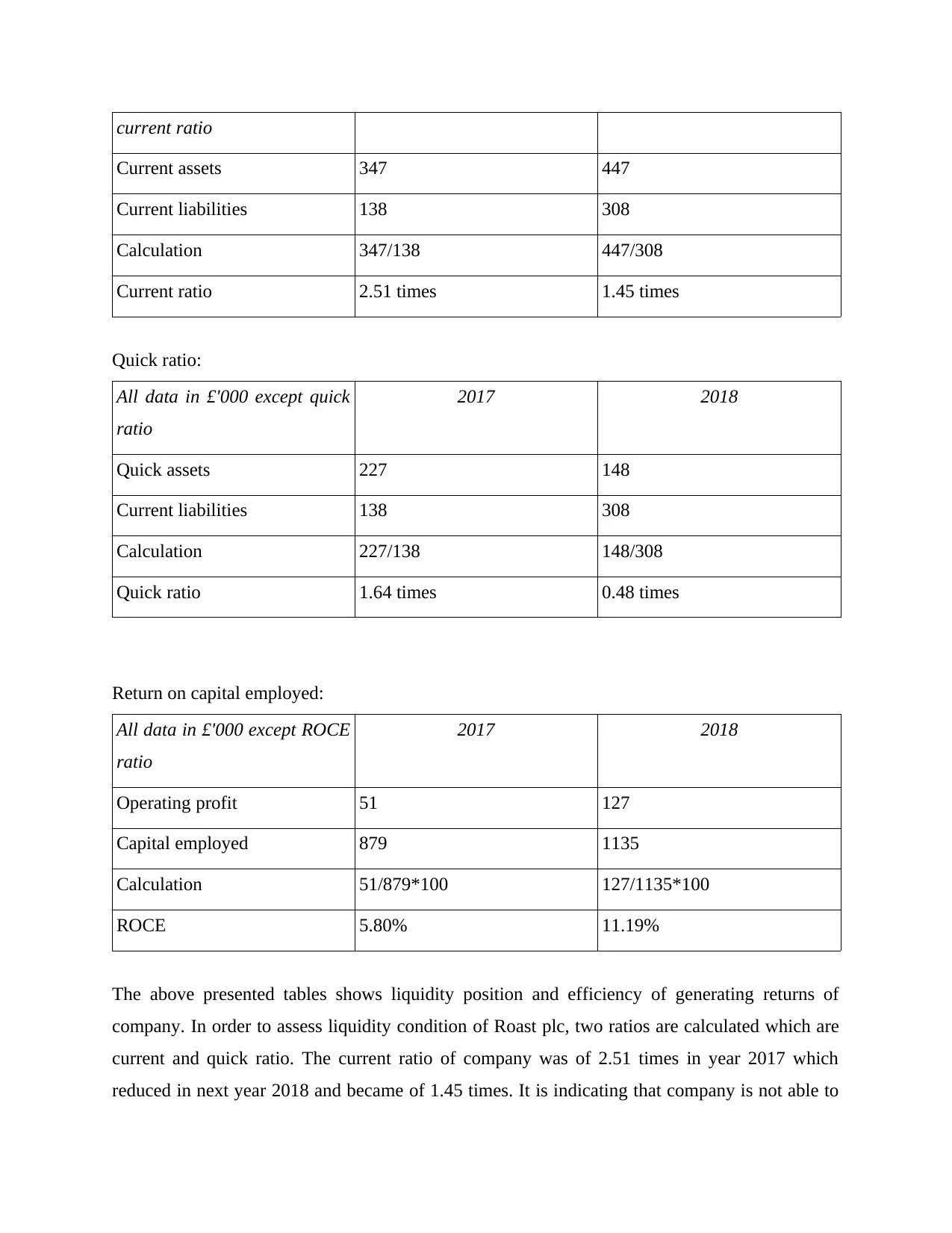
current ratio
Current assets 347 447
Current liabilities 138 308
Calculation 347/138 447/308
Current ratio 2.51 times 1.45 times
Quick ratio:
All data in £'000 except quick
ratio
2017 2018
Quick assets 227 148
Current liabilities 138 308
Calculation 227/138 148/308
Quick ratio 1.64 times 0.48 times
Return on capital employed:
All data in £'000 except ROCE
ratio
2017 2018
Operating profit 51 127
Capital employed 879 1135
Calculation 51/879*100 127/1135*100
ROCE 5.80% 11.19%
The above presented tables shows liquidity position and efficiency of generating returns of
company. In order to assess liquidity condition of Roast plc, two ratios are calculated which are
current and quick ratio. The current ratio of company was of 2.51 times in year 2017 which
reduced in next year 2018 and became of 1.45 times. It is indicating that company is not able to
Current assets 347 447
Current liabilities 138 308
Calculation 347/138 447/308
Current ratio 2.51 times 1.45 times
Quick ratio:
All data in £'000 except quick
ratio
2017 2018
Quick assets 227 148
Current liabilities 138 308
Calculation 227/138 148/308
Quick ratio 1.64 times 0.48 times
Return on capital employed:
All data in £'000 except ROCE
ratio
2017 2018
Operating profit 51 127
Capital employed 879 1135
Calculation 51/879*100 127/1135*100
ROCE 5.80% 11.19%
The above presented tables shows liquidity position and efficiency of generating returns of
company. In order to assess liquidity condition of Roast plc, two ratios are calculated which are
current and quick ratio. The current ratio of company was of 2.51 times in year 2017 which
reduced in next year 2018 and became of 1.45 times. It is indicating that company is not able to
Paraphrase This Document
Need a fresh take? Get an instant paraphrase of this document with our AI Paraphraser
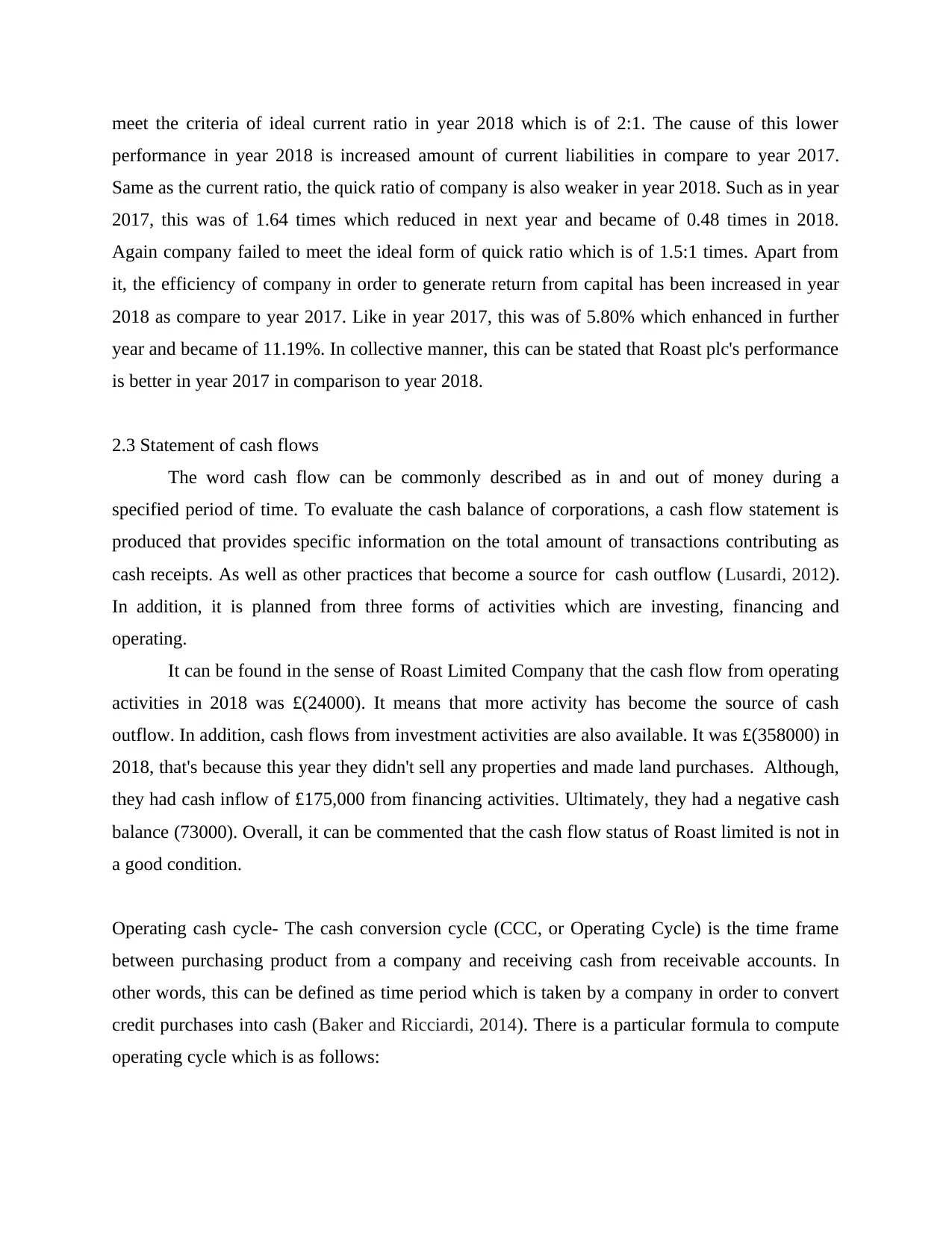
meet the criteria of ideal current ratio in year 2018 which is of 2:1. The cause of this lower
performance in year 2018 is increased amount of current liabilities in compare to year 2017.
Same as the current ratio, the quick ratio of company is also weaker in year 2018. Such as in year
2017, this was of 1.64 times which reduced in next year and became of 0.48 times in 2018.
Again company failed to meet the ideal form of quick ratio which is of 1.5:1 times. Apart from
it, the efficiency of company in order to generate return from capital has been increased in year
2018 as compare to year 2017. Like in year 2017, this was of 5.80% which enhanced in further
year and became of 11.19%. In collective manner, this can be stated that Roast plc's performance
is better in year 2017 in comparison to year 2018.
2.3 Statement of cash flows
The word cash flow can be commonly described as in and out of money during a
specified period of time. To evaluate the cash balance of corporations, a cash flow statement is
produced that provides specific information on the total amount of transactions contributing as
cash receipts. As well as other practices that become a source for cash outflow (Lusardi, 2012).
In addition, it is planned from three forms of activities which are investing, financing and
operating.
It can be found in the sense of Roast Limited Company that the cash flow from operating
activities in 2018 was £(24000). It means that more activity has become the source of cash
outflow. In addition, cash flows from investment activities are also available. It was £(358000) in
2018, that's because this year they didn't sell any properties and made land purchases. Although,
they had cash inflow of £175,000 from financing activities. Ultimately, they had a negative cash
balance (73000). Overall, it can be commented that the cash flow status of Roast limited is not in
a good condition.
Operating cash cycle- The cash conversion cycle (CCC, or Operating Cycle) is the time frame
between purchasing product from a company and receiving cash from receivable accounts. In
other words, this can be defined as time period which is taken by a company in order to convert
credit purchases into cash (Baker and Ricciardi, 2014). There is a particular formula to compute
operating cycle which is as follows:
performance in year 2018 is increased amount of current liabilities in compare to year 2017.
Same as the current ratio, the quick ratio of company is also weaker in year 2018. Such as in year
2017, this was of 1.64 times which reduced in next year and became of 0.48 times in 2018.
Again company failed to meet the ideal form of quick ratio which is of 1.5:1 times. Apart from
it, the efficiency of company in order to generate return from capital has been increased in year
2018 as compare to year 2017. Like in year 2017, this was of 5.80% which enhanced in further
year and became of 11.19%. In collective manner, this can be stated that Roast plc's performance
is better in year 2017 in comparison to year 2018.
2.3 Statement of cash flows
The word cash flow can be commonly described as in and out of money during a
specified period of time. To evaluate the cash balance of corporations, a cash flow statement is
produced that provides specific information on the total amount of transactions contributing as
cash receipts. As well as other practices that become a source for cash outflow (Lusardi, 2012).
In addition, it is planned from three forms of activities which are investing, financing and
operating.
It can be found in the sense of Roast Limited Company that the cash flow from operating
activities in 2018 was £(24000). It means that more activity has become the source of cash
outflow. In addition, cash flows from investment activities are also available. It was £(358000) in
2018, that's because this year they didn't sell any properties and made land purchases. Although,
they had cash inflow of £175,000 from financing activities. Ultimately, they had a negative cash
balance (73000). Overall, it can be commented that the cash flow status of Roast limited is not in
a good condition.
Operating cash cycle- The cash conversion cycle (CCC, or Operating Cycle) is the time frame
between purchasing product from a company and receiving cash from receivable accounts. In
other words, this can be defined as time period which is taken by a company in order to convert
credit purchases into cash (Baker and Ricciardi, 2014). There is a particular formula to compute
operating cycle which is as follows:
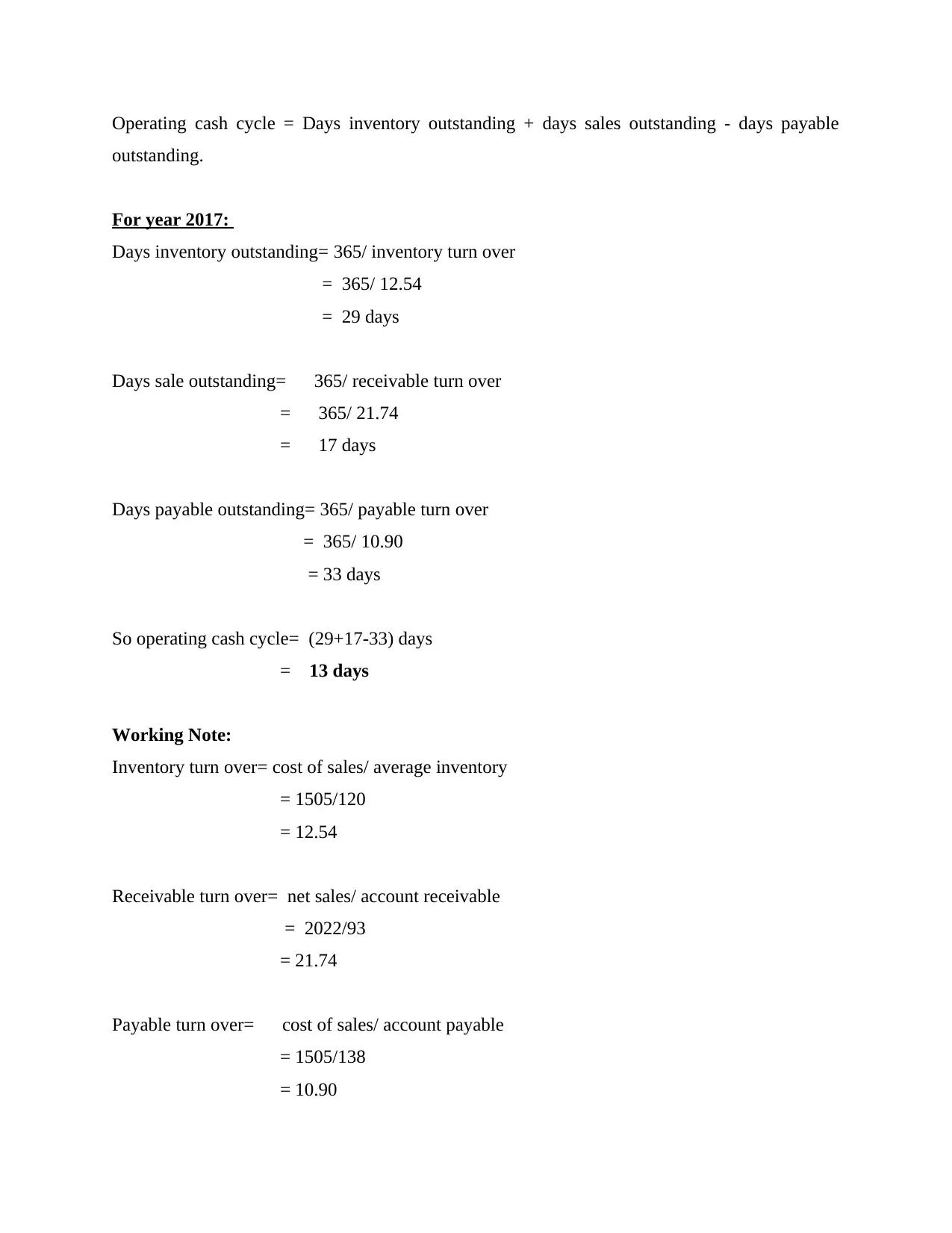
Operating cash cycle = Days inventory outstanding + days sales outstanding - days payable
outstanding.
For year 2017:
Days inventory outstanding= 365/ inventory turn over
= 365/ 12.54
= 29 days
Days sale outstanding= 365/ receivable turn over
= 365/ 21.74
= 17 days
Days payable outstanding= 365/ payable turn over
= 365/ 10.90
= 33 days
So operating cash cycle= (29+17-33) days
= 13 days
Working Note:
Inventory turn over= cost of sales/ average inventory
= 1505/120
= 12.54
Receivable turn over= net sales/ account receivable
= 2022/93
= 21.74
Payable turn over= cost of sales/ account payable
= 1505/138
= 10.90
outstanding.
For year 2017:
Days inventory outstanding= 365/ inventory turn over
= 365/ 12.54
= 29 days
Days sale outstanding= 365/ receivable turn over
= 365/ 21.74
= 17 days
Days payable outstanding= 365/ payable turn over
= 365/ 10.90
= 33 days
So operating cash cycle= (29+17-33) days
= 13 days
Working Note:
Inventory turn over= cost of sales/ average inventory
= 1505/120
= 12.54
Receivable turn over= net sales/ account receivable
= 2022/93
= 21.74
Payable turn over= cost of sales/ account payable
= 1505/138
= 10.90
⊘ This is a preview!⊘
Do you want full access?
Subscribe today to unlock all pages.

Trusted by 1+ million students worldwide
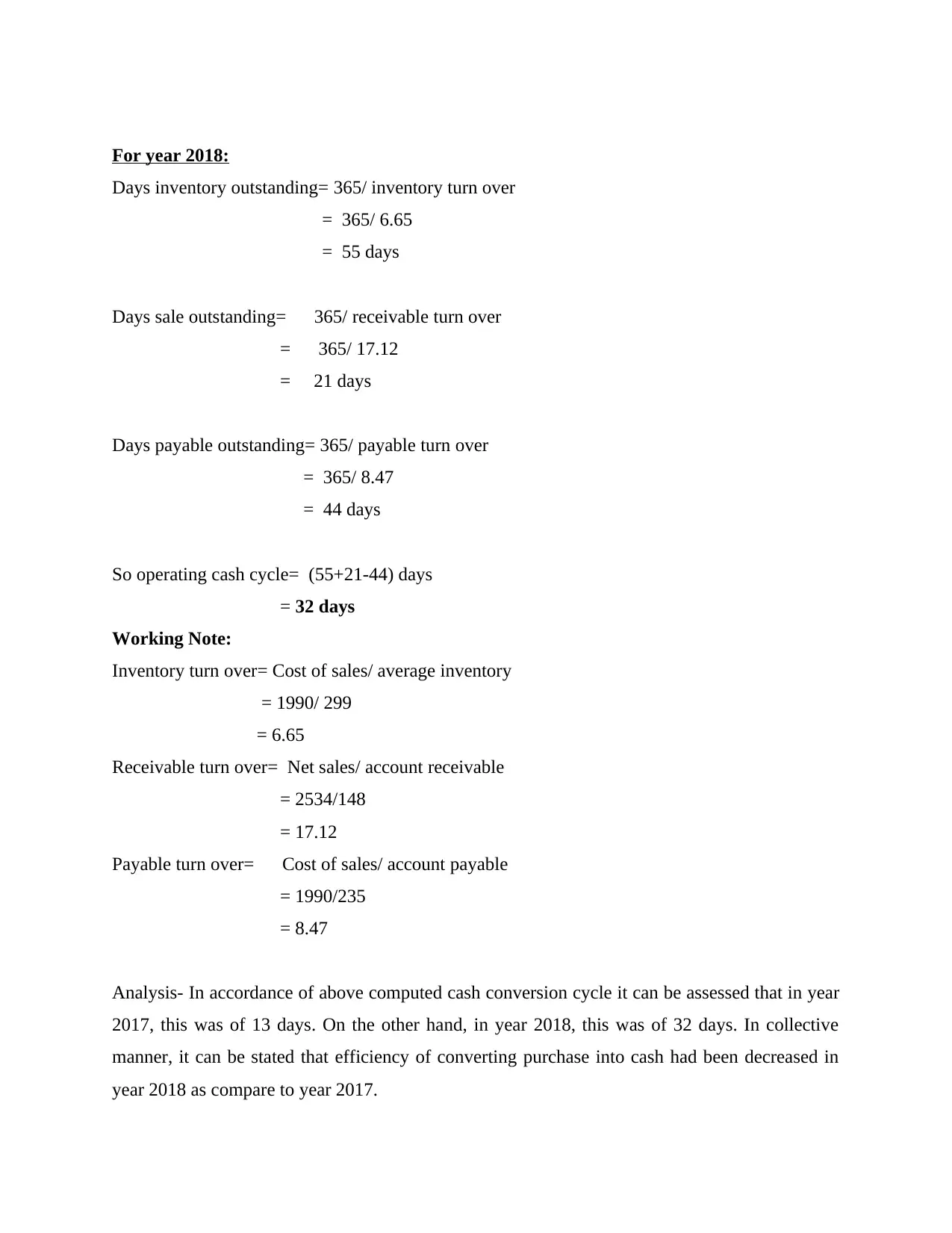
For year 2018:
Days inventory outstanding= 365/ inventory turn over
= 365/ 6.65
= 55 days
Days sale outstanding= 365/ receivable turn over
= 365/ 17.12
= 21 days
Days payable outstanding= 365/ payable turn over
= 365/ 8.47
= 44 days
So operating cash cycle= (55+21-44) days
= 32 days
Working Note:
Inventory turn over= Cost of sales/ average inventory
= 1990/ 299
= 6.65
Receivable turn over= Net sales/ account receivable
= 2534/148
= 17.12
Payable turn over= Cost of sales/ account payable
= 1990/235
= 8.47
Analysis- In accordance of above computed cash conversion cycle it can be assessed that in year
2017, this was of 13 days. On the other hand, in year 2018, this was of 32 days. In collective
manner, it can be stated that efficiency of converting purchase into cash had been decreased in
year 2018 as compare to year 2017.
Days inventory outstanding= 365/ inventory turn over
= 365/ 6.65
= 55 days
Days sale outstanding= 365/ receivable turn over
= 365/ 17.12
= 21 days
Days payable outstanding= 365/ payable turn over
= 365/ 8.47
= 44 days
So operating cash cycle= (55+21-44) days
= 32 days
Working Note:
Inventory turn over= Cost of sales/ average inventory
= 1990/ 299
= 6.65
Receivable turn over= Net sales/ account receivable
= 2534/148
= 17.12
Payable turn over= Cost of sales/ account payable
= 1990/235
= 8.47
Analysis- In accordance of above computed cash conversion cycle it can be assessed that in year
2017, this was of 13 days. On the other hand, in year 2018, this was of 32 days. In collective
manner, it can be stated that efficiency of converting purchase into cash had been decreased in
year 2018 as compare to year 2017.
Paraphrase This Document
Need a fresh take? Get an instant paraphrase of this document with our AI Paraphraser
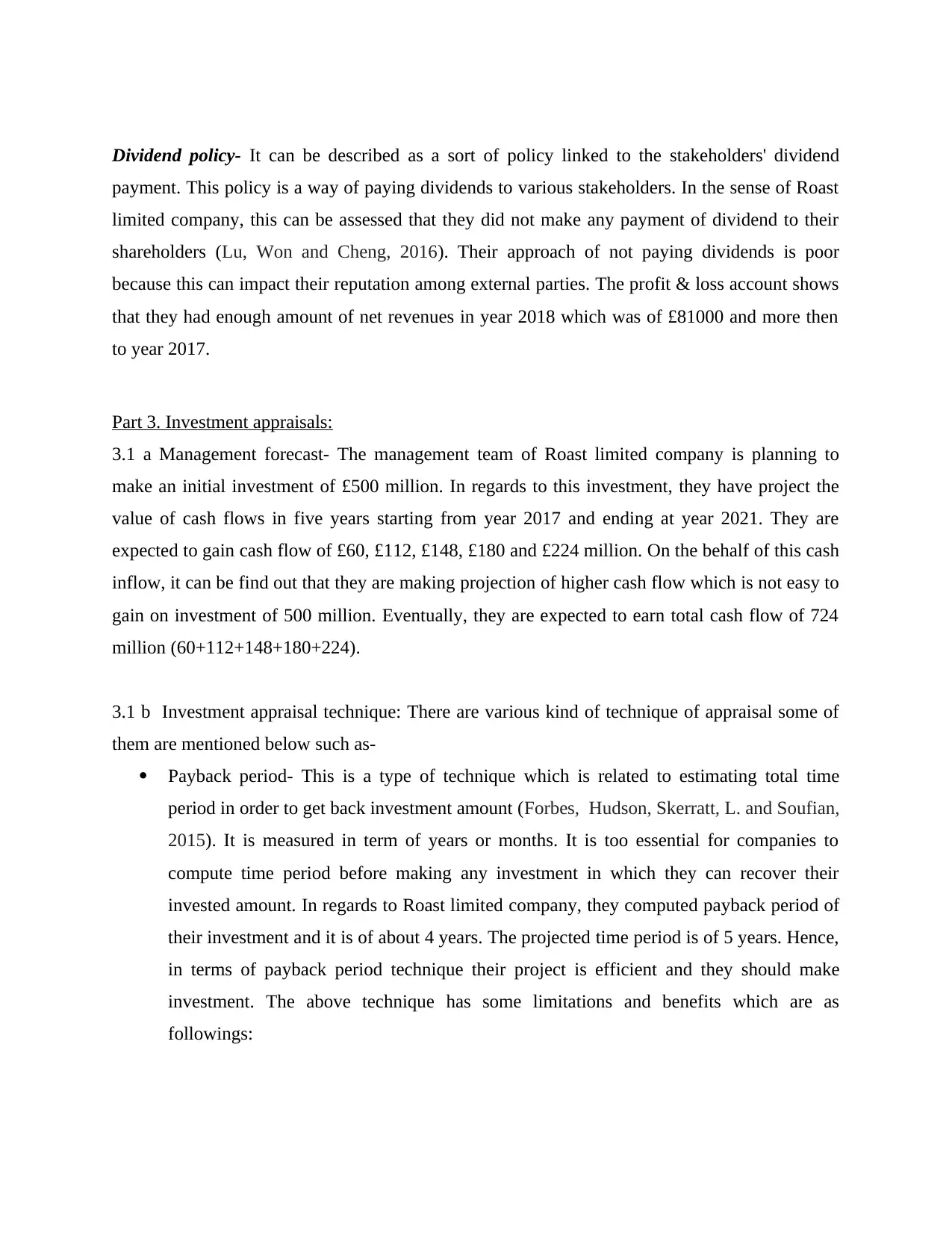
Dividend policy- It can be described as a sort of policy linked to the stakeholders' dividend
payment. This policy is a way of paying dividends to various stakeholders. In the sense of Roast
limited company, this can be assessed that they did not make any payment of dividend to their
shareholders (Lu, Won and Cheng, 2016). Their approach of not paying dividends is poor
because this can impact their reputation among external parties. The profit & loss account shows
that they had enough amount of net revenues in year 2018 which was of £81000 and more then
to year 2017.
Part 3. Investment appraisals:
3.1 a Management forecast- The management team of Roast limited company is planning to
make an initial investment of £500 million. In regards to this investment, they have project the
value of cash flows in five years starting from year 2017 and ending at year 2021. They are
expected to gain cash flow of £60, £112, £148, £180 and £224 million. On the behalf of this cash
inflow, it can be find out that they are making projection of higher cash flow which is not easy to
gain on investment of 500 million. Eventually, they are expected to earn total cash flow of 724
million (60+112+148+180+224).
3.1 b Investment appraisal technique: There are various kind of technique of appraisal some of
them are mentioned below such as-
Payback period- This is a type of technique which is related to estimating total time
period in order to get back investment amount (Forbes, Hudson, Skerratt, L. and Soufian,
2015). It is measured in term of years or months. It is too essential for companies to
compute time period before making any investment in which they can recover their
invested amount. In regards to Roast limited company, they computed payback period of
their investment and it is of about 4 years. The projected time period is of 5 years. Hence,
in terms of payback period technique their project is efficient and they should make
investment. The above technique has some limitations and benefits which are as
followings:
payment. This policy is a way of paying dividends to various stakeholders. In the sense of Roast
limited company, this can be assessed that they did not make any payment of dividend to their
shareholders (Lu, Won and Cheng, 2016). Their approach of not paying dividends is poor
because this can impact their reputation among external parties. The profit & loss account shows
that they had enough amount of net revenues in year 2018 which was of £81000 and more then
to year 2017.
Part 3. Investment appraisals:
3.1 a Management forecast- The management team of Roast limited company is planning to
make an initial investment of £500 million. In regards to this investment, they have project the
value of cash flows in five years starting from year 2017 and ending at year 2021. They are
expected to gain cash flow of £60, £112, £148, £180 and £224 million. On the behalf of this cash
inflow, it can be find out that they are making projection of higher cash flow which is not easy to
gain on investment of 500 million. Eventually, they are expected to earn total cash flow of 724
million (60+112+148+180+224).
3.1 b Investment appraisal technique: There are various kind of technique of appraisal some of
them are mentioned below such as-
Payback period- This is a type of technique which is related to estimating total time
period in order to get back investment amount (Forbes, Hudson, Skerratt, L. and Soufian,
2015). It is measured in term of years or months. It is too essential for companies to
compute time period before making any investment in which they can recover their
invested amount. In regards to Roast limited company, they computed payback period of
their investment and it is of about 4 years. The projected time period is of 5 years. Hence,
in terms of payback period technique their project is efficient and they should make
investment. The above technique has some limitations and benefits which are as
followings:
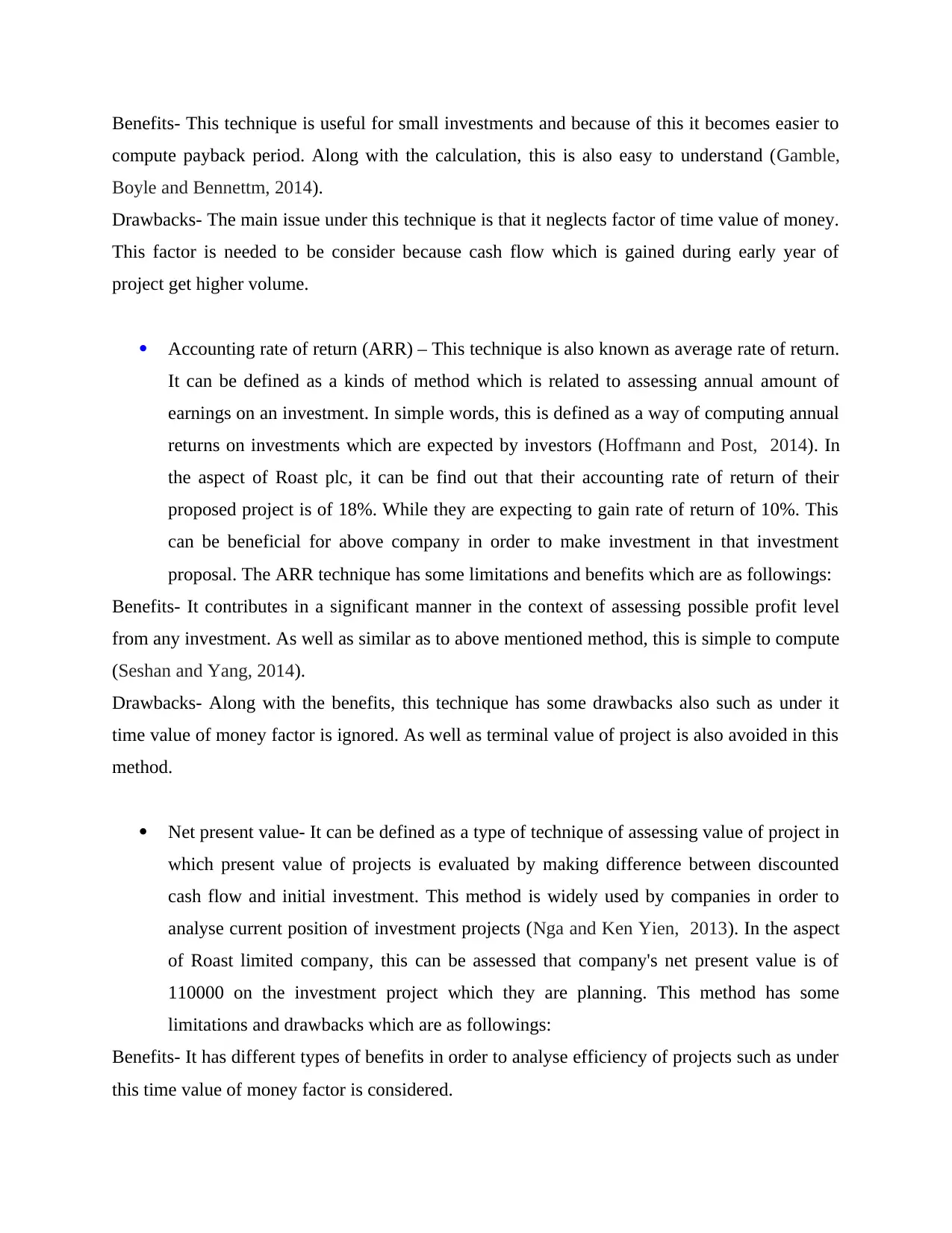
Benefits- This technique is useful for small investments and because of this it becomes easier to
compute payback period. Along with the calculation, this is also easy to understand (Gamble,
Boyle and Bennettm, 2014).
Drawbacks- The main issue under this technique is that it neglects factor of time value of money.
This factor is needed to be consider because cash flow which is gained during early year of
project get higher volume.
Accounting rate of return (ARR) – This technique is also known as average rate of return.
It can be defined as a kinds of method which is related to assessing annual amount of
earnings on an investment. In simple words, this is defined as a way of computing annual
returns on investments which are expected by investors (Hoffmann and Post, 2014). In
the aspect of Roast plc, it can be find out that their accounting rate of return of their
proposed project is of 18%. While they are expecting to gain rate of return of 10%. This
can be beneficial for above company in order to make investment in that investment
proposal. The ARR technique has some limitations and benefits which are as followings:
Benefits- It contributes in a significant manner in the context of assessing possible profit level
from any investment. As well as similar as to above mentioned method, this is simple to compute
(Seshan and Yang, 2014).
Drawbacks- Along with the benefits, this technique has some drawbacks also such as under it
time value of money factor is ignored. As well as terminal value of project is also avoided in this
method.
Net present value- It can be defined as a type of technique of assessing value of project in
which present value of projects is evaluated by making difference between discounted
cash flow and initial investment. This method is widely used by companies in order to
analyse current position of investment projects (Nga and Ken Yien, 2013). In the aspect
of Roast limited company, this can be assessed that company's net present value is of
110000 on the investment project which they are planning. This method has some
limitations and drawbacks which are as followings:
Benefits- It has different types of benefits in order to analyse efficiency of projects such as under
this time value of money factor is considered.
compute payback period. Along with the calculation, this is also easy to understand (Gamble,
Boyle and Bennettm, 2014).
Drawbacks- The main issue under this technique is that it neglects factor of time value of money.
This factor is needed to be consider because cash flow which is gained during early year of
project get higher volume.
Accounting rate of return (ARR) – This technique is also known as average rate of return.
It can be defined as a kinds of method which is related to assessing annual amount of
earnings on an investment. In simple words, this is defined as a way of computing annual
returns on investments which are expected by investors (Hoffmann and Post, 2014). In
the aspect of Roast plc, it can be find out that their accounting rate of return of their
proposed project is of 18%. While they are expecting to gain rate of return of 10%. This
can be beneficial for above company in order to make investment in that investment
proposal. The ARR technique has some limitations and benefits which are as followings:
Benefits- It contributes in a significant manner in the context of assessing possible profit level
from any investment. As well as similar as to above mentioned method, this is simple to compute
(Seshan and Yang, 2014).
Drawbacks- Along with the benefits, this technique has some drawbacks also such as under it
time value of money factor is ignored. As well as terminal value of project is also avoided in this
method.
Net present value- It can be defined as a type of technique of assessing value of project in
which present value of projects is evaluated by making difference between discounted
cash flow and initial investment. This method is widely used by companies in order to
analyse current position of investment projects (Nga and Ken Yien, 2013). In the aspect
of Roast limited company, this can be assessed that company's net present value is of
110000 on the investment project which they are planning. This method has some
limitations and drawbacks which are as followings:
Benefits- It has different types of benefits in order to analyse efficiency of projects such as under
this time value of money factor is considered.
⊘ This is a preview!⊘
Do you want full access?
Subscribe today to unlock all pages.

Trusted by 1+ million students worldwide
1 out of 15
Related Documents
Your All-in-One AI-Powered Toolkit for Academic Success.
+13062052269
info@desklib.com
Available 24*7 on WhatsApp / Email
![[object Object]](/_next/static/media/star-bottom.7253800d.svg)
Unlock your academic potential
Copyright © 2020–2025 A2Z Services. All Rights Reserved. Developed and managed by ZUCOL.





